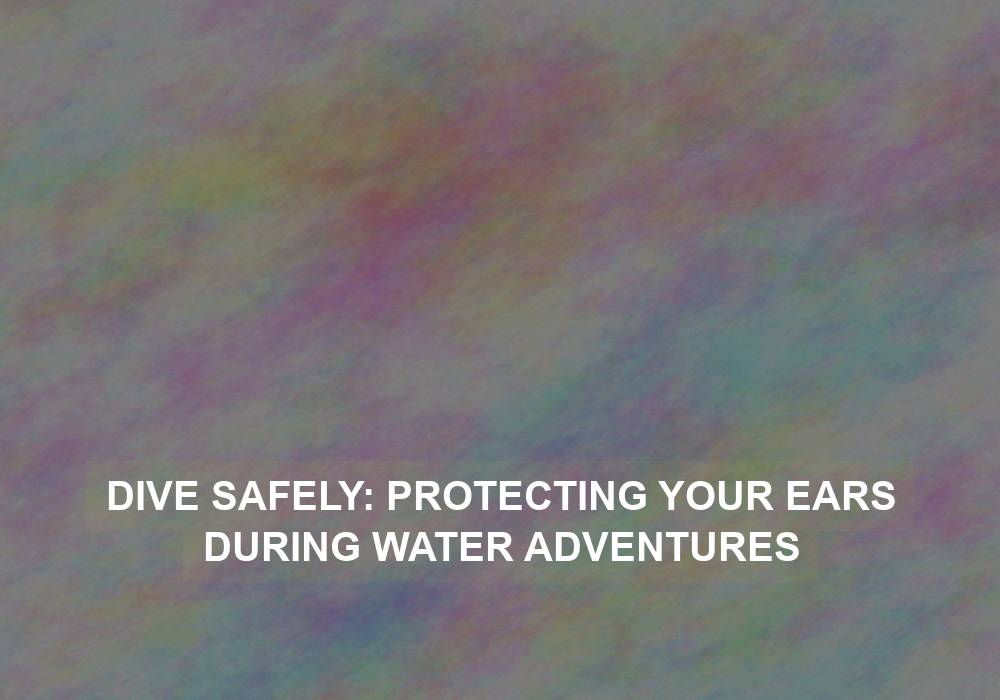Diving and other water activities offer a thrilling experience, allowing us to explore the beautiful underwater world. However, it is crucial to prioritize safety while indulging in these adventures. One aspect of safety that is often overlooked is protecting our ears. In this article, we will delve into the importance of ear protection during water adventures and provide valuable tips to ensure your ears stay safe and healthy.
Understanding the Anatomy of the Ear
Before we delve into the tips and techniques for protecting your ears, let’s take a moment to understand the anatomy of the ear. The ear can be divided into three main parts: the outer ear, the middle ear, and the inner ear.
- The outer ear consists of the pinna, which is the visible part, and the ear canal. It serves as a protective barrier, preventing foreign objects from entering the ear.
- The middle ear contains the eardrum and three small bones called ossicles – the hammer, anvil, and stirrup. These bones transmit sound vibrations from the eardrum to the inner ear.
- The inner ear houses the cochlea, which is responsible for hearing, and the vestibular system, which helps with balance. It is a delicate and intricate structure that must be protected from damage.
Now that we have a basic understanding of the ear’s structure, let’s explore why protecting it during water adventures is so important.
The Impact of Water Pressure on the Ears
When you dive or engage in water activities, the water pressure can have a significant impact on your ears. As you descend into the water, the pressure around you increases. This change in pressure can cause discomfort and even damage to your ears if not properly managed.
One common condition caused by pressure changes is ear barotrauma. It occurs when the pressure inside the middle ear and the pressure outside the ear are not equalized. This imbalance can lead to ear pain, hearing loss, dizziness, or even a ruptured eardrum.
To prevent ear barotrauma, it is essential to equalize the pressure in your ears. The most common method is called the Valsalva maneuver. To perform this technique, follow these steps:
- Pinch your nostrils closed with your fingers.
- Gently blow air through your nose while keeping your mouth closed.
This technique helps equalize the pressure inside your ears with the external pressure, reducing the risk of barotrauma.
Tips for Protecting Your Ears
To ensure your ears are well-protected during water adventures, follow these essential tips:
1. Equalize the Pressure
Equalizing the pressure in your ears is crucial to prevent barotrauma. In addition to the Valsalva maneuver, there are other techniques you can try, such as the Toynbee maneuver and the Frenzel maneuver. These techniques involve swallowing, yawning, or moving your jaw to help equalize the pressure in your ears. Experiment with different techniques to find what works best for you.
2. Use Earplugs or a Hood
Wearing ear protection, such as earplugs or a hood, can provide an extra layer of defense for your ears. These protective gears create a barrier that helps minimize the impact of pressure changes during dives. Make sure to choose earplugs or a hood that fit comfortably and securely to effectively seal off your ears from water.
3. Descend and Ascend Slowly
Rapid changes in depth can put excessive pressure on your ears. To avoid this, descend and ascend slowly, allowing your ears ample time to adjust to the pressure changes. Equalize the pressure in your ears every few feet or as needed during the descent and ascent. Being patient and taking it slow will greatly reduce the risk of ear-related issues.
4. Maintain Good Ear Hygiene
Good ear hygiene is essential for preventing infections and other ear-related problems. After each water adventure, ensure you thoroughly dry your ears with a towel or a hair dryer set on the lowest heat setting. It is also advisable to use ear drops specifically formulated for drying ears to gently remove any excess moisture. Avoid inserting cotton swabs or any other objects into your ears, as they can push wax deeper into the ear canal and potentially cause damage.
5. Avoid Smoking and Alcohol
Smoking and alcohol consumption can exacerbate the risk of ear problems. Both substances can lead to inflammation and negatively affect the Eustachian tubes, which are responsible for equalizing the pressure in your ears. It is best to refrain from smoking and limit alcohol consumption, particularly before and during water adventures. Prioritize your ear health by making healthy lifestyle choices.
6. Seek Professional Guidance
If you are new to diving or experiencing any ear-related issues, it is crucial to seek professional guidance. Consulting with a diving instructor or an ear specialist, such as an otolaryngologist, can provide valuable insights and ensure that you are taking the necessary precautions to protect your ears. They can also assess your overall ear health and provide personalized recommendations based on your specific needs.
By following these tips and prioritizing ear protection, you can fully enjoy your water adventures while minimizing the risk of ear-related complications.
Conclusion
Diving safely involves more than just wearing the right gear and following proper techniques. Protecting your ears should be a top priority to avoid discomfort, pain, and potential damage. By understanding the anatomy of the ear, equalizing pressure, using ear protection, maintaining good ear hygiene, and seeking professional guidance when needed, you can ensure your ears remain healthy and protected during all your water adventures. Stay safe and enjoy the wonders of the underwater world!
